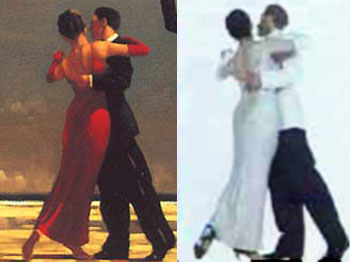
I've always been a fan of the surreal. (Maybe my life has seemed surreal to me, even before I knew the meaning of the word.) My earliest art memories (late 1950's) are of dreamlike paintings in the halls of the Biltmore Hotel in downtown Los Angeles; my mother and I would always go there for lunch after a concert at the Philharmonic Auditorium across the street, and soon I became quite adept at spotting a Robert Watson painting from afar and among all of the landscapes, portraits, and still-lifes displayed for sale. The paintings' lonely mood touched and moved me. I fantasized about saving up my allowance and buying one, which at that time was around $200.
Years later I went to a Salvador Dali exhibit at Hollywood's Barnsdall Gallery, and by then the art of the surreal had hooked me. And I had yet to discover René Magritte!
So, as a tango dancer, I too was attracted to Jack Vettriano's painting of The Singing Butler before it became kitsch and on the walls of every dance studio in the world. He also paints other dance scenes that are lesser known, but tangueros are especially drawn to The Singing Butler because the mirrored leg position shows it's a tango on the beach, and not a waltz or a foxtrot.

The Walzers

Dance to the End of Love

Billy Boys, who sure look like a group of tangueros on their way either to or from a milonga.

But the most well-known is The Singing Butler. The dancers here are not lonely, but in their own private world of the tango embrace, while sheltered by paid help who modestly look away. Perhaps the butler is singing "Por Una Cabeza?"
People have been inspired by this painting to do take-offs and photo recreations, but what most don't know is that Vettriano himself was inspired by the depictions of dancers in an art textbook! Didn't you wonder why the dancers are portrayed backwards?

C.Dedeene designed the choreography for this Vettriano take off and the photo is by Greta Colpaert

Vettriano in Devon photo by Steve Morrall
Vettriano's secret
Works by Jack Vettriano, Scotland's most famous artist have fetched record prices at auction. But his paintings may owe a lot to teach-yourself manuals. Some of his works show strong similarities to an artist's teaching manual. His most famous work, the Singing Butler, was last year sold for almost £750,000. It was revealed that its characters, and many others, can be found in The Illustrator's Figure Reference Manual, published in 1987.
Another article on Vettriano's inspirations here.
Here are some other works which may have inspired The Singing Butler, or were rather inspired by Magritte. What is it about black umbrellas, water, and raining men?

The Wolverine Magritte

Photo by Joseph Hancock

Golconda by Rene Magritte


4 comments:
Por la posición de las cabezas de los bailarines, Vettriano pintaba más bien un "ballroom" que una milonga. Y el cuadro del mayordomo cantor tal vez podría llevar el nombre "Tango zurdo" porque el abrazo está invertido. La hermosa foto de Greta devuelve las cosas a su lugar. Inspirador post, Cherie.
Cherie,
The Singing Butler is hanging on the wall of my home tango studio. And I thought I was unique!!
I don't think the embrace is more ballroom more tango. In ballroom tango there is no contact at the level of the chest. Maybe Vettriano is pointing out that the British got it wrong with tango, like when they created international tango. Or maybe the dancers are mixed up just like the British manner of driving on the wrong side of the road!!
Ron
Hey Ron,
We drive on the correct side of the road, everyone else is wrong.
But that is not why I was commenting. I thought for just a moment Cherie, you were going to tell me why the hold is the wrong way around. I have that picture in my lounge and have often wondered.
I thought it was just because he was an ex miner and not a dancer.
Thank you so much for the art history lesson, Cherie! I was not familiar with the work of Vettriano. You've inspired me to learn more about him. :)
Post a Comment